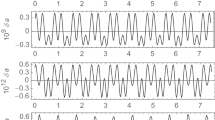Abstract
Perturbation techniques based on Lie transforms as suggested by Deprit were used as the theoretical foundation for programming the analytical solution of the Main Problem in Satellite Theory (all gravitational harmonics being zero exceptJ 2). The collection of formulas necessary and sufficient to construct an ephemeris is given in the exposition. Short and long period displacements, as well as the secular terms, have been obtained up to the third order inJ 2 as power series of the eccentricity. They result from two successive completely canonical transformations which it has been found convenient not to compose into a unique transformation. Division by the eccentricity appears nowhere in the developments-neither explicitly nor implicitly. The determination of the constants of motion from the initial conditions has been given an elementary solution that is both complete and explicit without being iterative. The program was developed by Rom from MAO's package of subroutines forMechanizedAlgebraicOperations. Reliability tests have been run in two instances: in-track errors for ANNA 1B are only 20 cm after 210 days in orbit, while for RELAY II, they are 2.4 m, even after 350 days in orbit.
Similar content being viewed by others
References
Aksnes, K.: 1967,Astroph. Norv. 10, 156.
Arsenault, J. L., Enright, J. D., and Purcell, C.: 1964, ASTIA Documents 437-75 and 437-76.
Bonavito, N. L., Watson, S., and Walden, H.: 1969, NASA TN D-5203.
Brouwer, D.: 1959,Astron. J. 64, 378.
Brouwer, D. and Clemence, G. M.: 1961,Methods of Celestial Mechanics, Academic Press, New York, Ch.II, p. 79.
Brown, E. W. and Shook, C. A.: 1933,Planetary Theory, Cambridge University Press, Cambridge (G.B.), Ch. VI, p. 141et seq.
Cain, B. J.: 1962,Astron. J. 67, 391.
Delaunay, C.: 1867,Mémoires de l'Académie des Sciences 2g, p. 801.
Deprit, A.: 1969,Cel. Mech. 1, 12.
Deprit, A. and Rom, A.: 1967,Bull. Astron., Série 3,2, 425.
Deprit, A. and Zahar, R.: 1966,Zeit. angew. Math. Phys. 17, 425.
Lubowe, A. G.: 1966,AIAA J. 4, 361–63.
Meffroy, J.: 1968, NASA Goddard Space Flight Center Memorandum X-641-68-320.
Moses, J.: 1969, Tutorial Session, July 2, Summer Institute in Dynamical Astronomy, M.I.T., Cambridge, Mass.
Poincaré, H.: 1893,Les Méthodes nouvelles de la Mécanique céleste, Gauthier-Villars, Paris, Tome II, Chapitre VIII, p. 17et seq.
Rom, A.: 1969, Boeing Document D1-82-0840 submitted for publication inCel. Mech.
Author information
Authors and Affiliations
Rights and permissions
About this article
Cite this article
Deprit, A., Rom, A. The main problem of artificial satellite theory for small and moderate eccentricities. Celestial Mechanics 2, 166–206 (1970). https://doi.org/10.1007/BF01229494
Received:
Issue Date:
DOI: https://doi.org/10.1007/BF01229494




